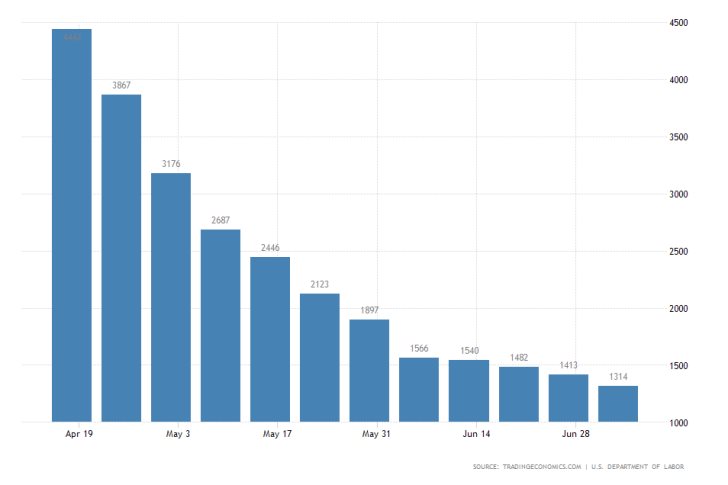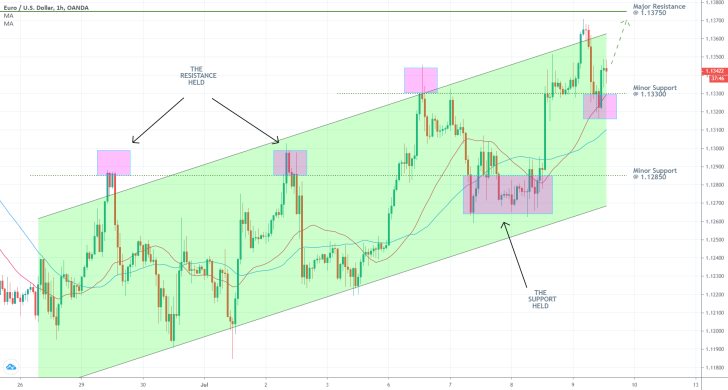
Earlier today, the US Department of Labour released its weekly labour force survey. The findings of the report revealed that another 1.314 million people have filed for unemployment benefits in the week ending the 4th of July.
The number measures a sizable drop from the 1.413 million that were recorded the week prior. Additionally, the latest data fell short of the consensus forecasts for 1.375 million.

Considering the latest data, the total number of people who have claimed unemployment benefits since the 21st of March has risen to 50 million. The hit on the labour market has been exacerbated by the coronavirus fallout, which continues to impact the way businesses in the US and elsewhere conduct their operations.
The likelihood of a second epidemic wave poses serious risks for the ongoing recovery process. The US Government could cease relaxing its containment restrictions in a bid to avert such a scenario, which would, unfortunately, impede the general economic activity as well.
If the number of newly confirmed cases continues to rise, which is currently happening in California and Texas, this could compel local authorities to reimpose more stringent lockdowns.
Such a course of action would undoubtedly jolt the political landscape in the US ahead of the upcoming November election, judging on the significant backlash that the initial lockdowns received from the Trump Administration.
A potential repeat of the situation would likely put Donald Trump at odds with local Governors once again, as the debate of whether more emphasis should be placed on healthcare or economics remains a hot button issue.
At any rate, a resurgence in the number of confirmed COVID-19 cases would threaten the tentative economic recovery, which is currently supported by the accommodative monetary and fiscal policies in the country.
Today's labour data could enhance the depreciation of the US dollar, which has been put under a lot of strain over the past several days. As can be seen on the hourly chart below, the greenback is presently struggling to recover against the euro.
The EURUSD is consolidating above the minor support level at 1.13300, and would likely attempt to test the strength of the major resistance level at 1.13750 in the near future.
That is so because the pair continues to advance within the boundaries of an ascending channel, whose upper boundary is currently converging with the aforementioned resistance.
The recent rebound of the price action from the 20-day MA (in purple) implies robust bullish commitment in the market.

Trendsharks Premium
Gold is undergoing a correction, as investors take profits to offset losses from falling stock prices, impacting their margins. However, we anticipate a renewed wave of [...]
The Swiss stock market index is mirroring its global counterparts, such as Germany 40 and US100, experiencing a sharp decline following the announcement of new [...]
We’re analyzing the weekly chart to grasp the broader market trend. Over the past three years, the US30 index has surged by 17,000 points, often resembling a nearly straight [...]
Over the past week, the DAX has experienced a sharp decline, plunging by an astonishing 3,400 points. This downward movement is not isolated, as its international counterparts, such as the UK100 and US100, are also facing significant [...]
EURUSD recently formed a double top at 1.0930, signaling a potential trend reversal, and has since begun a correction. After a 600-pip rally since early March, a pullback at this stage is both expected and healthy. Given these conditions, we are placing a [...]
Since early March, EURJPY has surged nearly 1,000 pips, providing us with several excellent trading opportunities. However, as the rally matures, many early buyers are beginning to take profits, leading to a noticeable slowdown in the uptrend. On Friday, the pair formed a [...]
The AUDJPY currency pair continues to be dominated by bullish momentum, as multiple golden cross patterns reaffirm the strength of the ongoing uptrend. Despite this, we are witnessing a much-needed [...]
The EURAUD currency pair appears to be undergoing a trend reversal, signaling a potential shift in market direction. A notable technical development is the formation of a Death Cross on the chart, a widely recognized bearish indicator that typically suggests a [...]
After securing an impressive 200-pip profit last week, the EURJPY currency pair is now undergoing a southward correction, retracing some of its recent gains. Despite this temporary pullback, the Golden Cross remains intact, reinforcing our view that the overall trend continues to be [...]
The appearance of a Golden Cross in Silver strengthens our analysis that the metal is currently in a strong uptrend, indicating further bullish momentum in the market. This technical pattern, where the short-term moving average crosses above the [...]
This trade presents a considerable level of risk and can be classified as an opportunistic move based on recent price action. The GBPUSD currency pair has experienced a substantial bullish rally, surging by nearly 500 pips in a strong upward movement. However, after this extended period of appreciation, the pair is showing signs of a potential [...]
The anticipated Death Cross on the SMI20 appears to be failing as price finds strong support at the 23% Fibonacci retracement level. After testing this area, the index has shown bullish strength, printing several large green candles, signaling an increase in [...]
A Golden Cross has just appeared on the USDJPY chart, signaling a potential bullish move. This technical pattern occurs when the 20 period moving average crosses above the 60 period moving average, a widely recognized indication of increasing [...]
After 2 months of a down trend, we finally see some indications of price recovery for Oil. The golden cross, a historic buy signal, supports this [...]
For the past month, the German DAX40 has experienced a remarkable 10% surge, reflecting strong bullish momentum. Despite ongoing market volatility and frequent pullbacks, every dip continues to attract fresh buyers, reinforcing the [...]
Oil continues its downward trajectory, despite occasional pullbacks. The overall trend remains bearish, reinforced by multiple Death Cross patterns, a classic sell signal indicating further weakness. Adding to this bearish outlook, the critical [...]
Over the past few days, gold has experienced a sharp decline of more than $100. This downturn can be attributed in part to traders securing profits to manage their margins, which are under strain due to the significant drop in major indices. Currently, gold has fallen below the [...]
The NASDAQ 100 index is showing strong bullish momentum, as evidenced by the formation of a Golden Cross on the chart. This classic buy signal occurs when the short moving average crosses above the long term moving average, suggesting that upward momentum is [...]
The EURAUD currency pair has encountered a significant resistance level, failing to break above the critical 61% Fibonacci retracement level. This suggests that bullish momentum is weakening, reinforcing the case for a potential downward move. Given this technical setup, we favor entering a [...]
The UK100 is experiencing a remarkable rally! Over the past few weeks, the British stock market index has surged nearly 800 points. Each minor dip has attracted more buyers, fueling the bullish momentum. However, since last week, we’ve observed a slight [...]




















